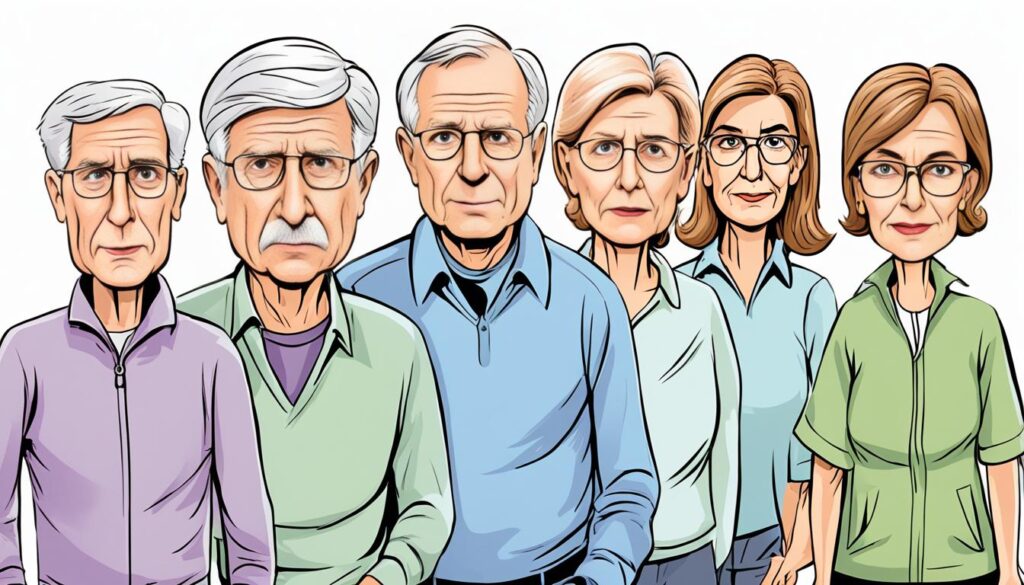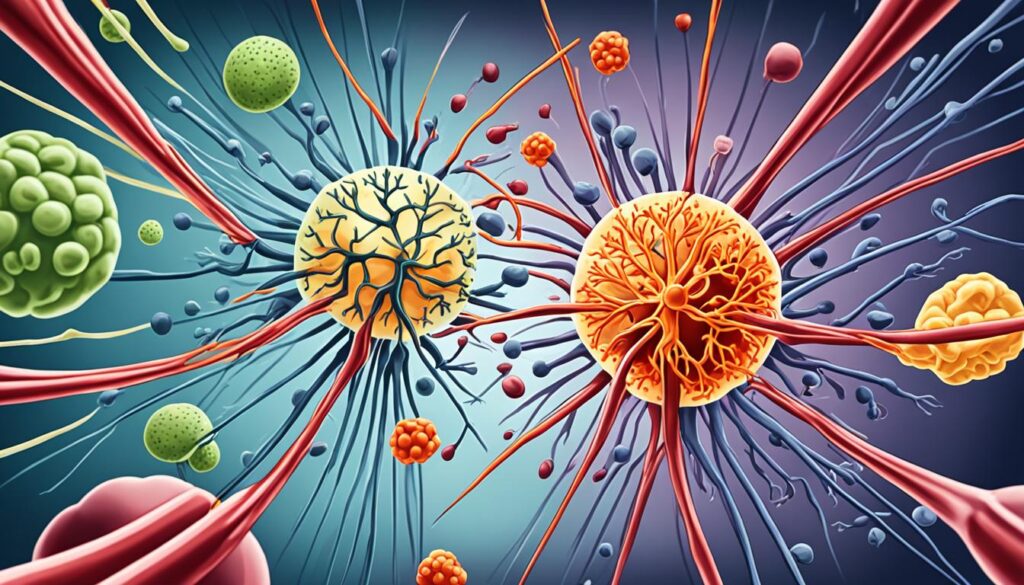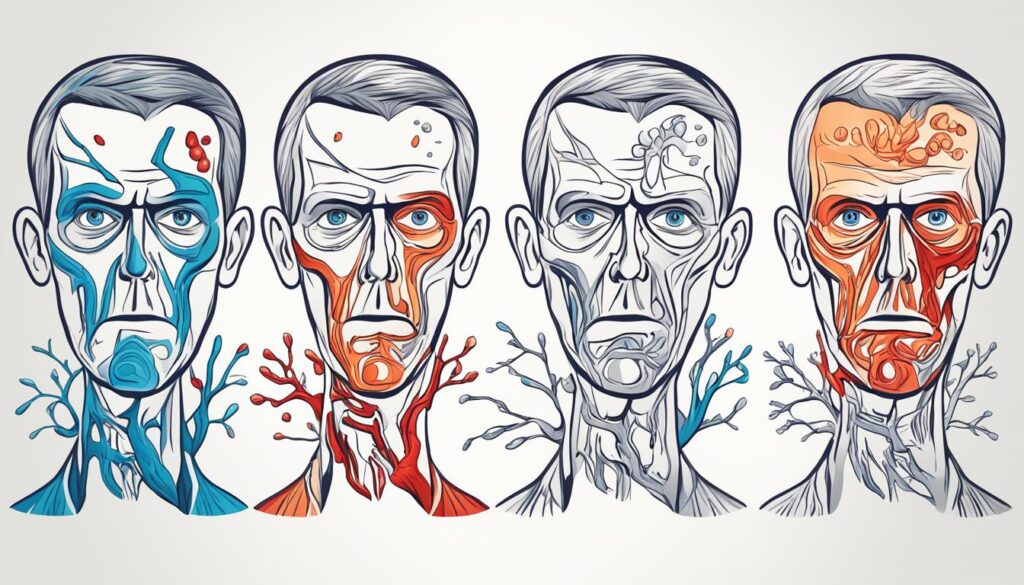Stiff person syndrome (SPS) is a rare, challenging to understand neurological disorder. It leads to muscle stiffness and painful spasms. These can be triggered by sudden noises or light touches. Sometimes, even cold can set them off. SPS is linked with the immune system causing trouble in various autoimmune disorders.
The real cause of SPS remains a mystery. However, experts think it’s tied to the immune system mistakenly attacking nerve cells. These cells make GABA, which is a key chemical for muscle control. If not managed well, SPS can really affect how someone does their daily tasks and routines.
Table of Contents
ToggleWhat is stiff person syndrome?
Definition and Overview
Stiff person syndrome (SPS) is a rare, acquired neurological disorder. It causes muscle stiffness and frequent painful spasms. SPS can vary in how severe it is and how it progresses. The condition develops slowly over months to years. It was first called “stiff man syndrome” but is now known to affect anyone, regardless of age, race, or gender.
Symptoms of Stiff Person Syndrome
SPS shows up as stiff muscles and sudden, painful spasms. It can start with a dull ache, especially in the lower back, hips, or legs. Over time, the legs and other parts of the body may become very stiff. This makes walking hard and slow.
Muscle spasms are a big part of SPS. They can happen for no reason or be set off by loud noises, light touches, or being in a cold or stressful place. The spasms are not only painful but also make the stiffness worse. In bad cases, SPS can make even simple tasks tough to do each day.
Who Is More Likely to Get Stiff Person Syndrome?
Stiff person syndrome, or SPS, affects twice as many females as males. It’s a rare neurological disorder tied to other autoimmune illnesses. These include type-I diabetes, thyroiditis, vitiligo, and pernicious anemia.
While earlier seen as very rare, affecting only about one to two people per million, views have changed. Experts think SPS might belong to a group of disorders, making it potentially more common. But, it’s still considered rare.

More cases in women match what’s seen with other autoimmune diseases. Scientists are looking into why this gender difference exists. They also seek possible causes and risk factors for developing SPS.
Causes of Stiff Person Syndrome
SPS’s exact cause isn’t known, but it’s likely linked to autoimmune issues. This happens when the body attacks its own healthy cells. In SPS, the immune system goes after nerve cells that make GAD. GAD helps produce GABA, a chemical that regulates muscle movement and nerve reactions.
Autoimmune Response
Those with SPS often have trouble with GAD, a key protein in certain nerve cells. This protein is important for making GABA. A drop in GABA due to immune attacks causes SPS symptoms. We’re still figuring out the exact link between GAD and SPS development.
Role of Anti-GAD Antibodies
In SPS, many show very high levels of GAD antibodies compared to usual. While high GAD levels happen in diabetes, SPS levels are even higher. They might also appear in the spinal fluid.
Association with Other Autoimmune Disorders
SPS often goes along with other autoimmune diseases. These can include type 1 diabetes, thyroid issues, and more. The link between SPS and these conditions hints at shared causes.
Paraneoplastic Stiff Person Syndrome
Occasionally, an SPS case is linked to cancer, called paraneoplastic SPS. Breast and lung cancer are often associated. Yet, less common cancers like lymphoma and thymoma can also be linked. The symptoms are much like classic SPS.

Types of Stiff Person Syndrome
Stiff person syndrome (SPS) is a group of neurological disorders. There are different types, each showing unique symptoms. Knowing the types is key to proper diagnosis and treatment.
Classic Stiff Person Syndrome
Classic SPS leads to muscle stiffness and painful spasms. They mainly affect the torso and legs instead of the arms. Symptoms show up slowly, and not everyone will have a curved lower spine at first.
Partial Stiff Person Syndrome
Partial SPS focuses the stiffness and spasms on one part of the body. This might be one leg or the torso. Over time, it can spread to affect both legs and more of the body. This makes walking harder and can lead to falls.
Stiff Person Syndrome Plus
SPS-plus includes classic SPS symptoms along with brainstem and/or cerebellar issues. This leads to double vision, vertigo, and more. As time goes on, walking may become very difficult. These people are also at a high risk of falling.
Progressive Encephalomyelitis with Rigidity and Myoclonus (PERM)
PERM involves muscle stiffness and pain like classic SPS but progresses more quickly. Stiffness can come on in days to a few weeks. Other symptoms might include vertigo or seizures. Many with PERM experience myoclonus.
Overlapping Syndromes
Some syndromes don’t neatly fall into the other categories of SPS. They can share symptoms with classic SPS and other conditions. This shows that SPS is a range of disorders, not just one disease.

Diagnosing Stiff Person Syndrome
Diagnosing stiff person syndrome (SPS) is hard. Its symptoms are like those from other problems, such as Parkinson’s. To confirm, doctors use a blood test. This test measures glutamic acid decarboxylase (GAD) antibodies levels. High levels show someone likely has SPS.
Blood Tests
A blood test to check for GAD antibodies is crucial for SPS. These antibodies are often found in people with SPS. They help separate SPS from other diseases that seem alike.
Electromyography (EMG)
Electromyography (EMG) checks nerve and muscle function. Before an EMG, pause SPS medications. This brief pause makes SPS signs clearer on the test.
Lumbar Puncture
A lumbar puncture, or spinal tap, is useful to exclude other problems. It also looks for SPS markers in the spinal fluid, like anti-GAD65 antibodies.
Imaging Studies
Imaging studies like an MRI or FDG-PET with CT scan show body structures. They help rule out other conditions that act like SPS. Sometimes, a mammogram is needed too, especially if cancer is suspected.
Treatment for Stiff Person Syndrome
Stiff person syndrome has no cure. Yet, medicines can help deal with its symptoms. Such as oral muscle relaxers like diazepam and clonazepam. These can ease spasms, stiffness, and pain. Drugs affecting the GABA neurotransmitter, like gabapentin, also play a role. They help lessen the symptoms of this syndrome.
Medications for Symptom Management
For localized muscle spasm, botulinum toxin injections are an option. Antidepressants as well, specifically SSRIs, can be taken. These help manage physical symptoms that anxiety causes.
Immune Therapies
For stiff person syndrome, immune therapies offer another route. They aim to tweak or calm down the immune system, thus addressing its autoimmune side. Options include intravenous or subcutaneous immunoglobulin and plasma exchange. Also, several immunosuppressant therapies like rituximab, mycophenolate mofetil, and azathioprine are used.
Non-Medication Treatments
Aside from drugs, several non-medication methods can also aid in managing the syndrome’s symptoms. Physical therapy plays a key role, including deep tissue techniques and stretching. This often involves balance and gait training alongside modalities such as ultrasound and heat. Aquatic therapy, electrostimulation, and stretching exercises are beneficial too. Other options are osteopathic manipulation, qi gong, chiropractic care, massage, and yoga. Cognitive therapies can also help. All these treatments when combined with medication, enhance the quality of life for those with SPS.
Living with Stiff Person Syndrome
Impact on Daily Activities
Stiff person syndrome can make daily tasks hard in serious cases. People may need help like canes or wheelchairs to move. They might worry about sudden muscle spasms and falling, making them afraid to go out. Without treatment, the illness can get worse, making it even harder to move.
Coping Strategies
Though there’s no cure, certain strategies can help you live better with SPS. These include physical and heat therapy. Using tools to ease daily work can also be beneficial. Avoiding things that make muscle spasms worse is key. Also, finding others with SPS and leaning on your healthcare team can offer support.

Prognosis and Disease Progression
The severity and progression of stiff person syndrome (SPS) can differ a lot. For some, the issue stays the same over many years. But for others, it can get worse slowly. Medication and treatments can help many manage their symptoms and stay functional.
Yet, if SPS isn’t treated well, it could worsen. This might lead to more disability and other health problems because of being less mobile. The outlook for those with SPS changes based on its type, how severe the symptoms are, and how they respond to treatment.
For some, SPS symptoms get worse gradually. But for others, they remain more or less stable. This can affect daily life differently for each person. Some might find it hard to do normal tasks as they get worse.
It’s key to see a healthcare provider skilled in treating SPS regularly. A strong treatment plan can help many keep their quality of life. This is despite the difficulties SPS may bring with it, being a rare condition that affects the nervous system.
Research and Clinical Trials
Researchers are working hard to find the causes of stiff person syndrome (SPS) and new treatments. Clinical trials are key in this research. They help us learn more about SPS and test new therapies. If you have SPS, joining a clinical trial could help the research and let you try new treatment options.
The National Institutes of Health (NIH) and other top organizations keep lists of ongoing SPS clinical trials. By keeping up with the latest research and SPS clinical trials, you can find chances to take part. This can lead to better treatments and maybe a better life.
Taking part in clinical trials is not just about helping research. It also lets you use new therapies that aren’t available yet. By working with your doctors and keeping up with new research, you can make a big difference in how SPS is treated in the future.
Conclusion
Stiff person syndrome is a rare, complex condition. It causes muscle stiffness and painful spasms. The main cause is likely an autoimmune issue. There might be genetic or environmental factors too. It can change how a person lives day to day. Yet, with the right care, many can lead fulfilling lives.
To diagnose the syndrome, doctors use a mix of exams, tests, and scans. Current treatments help lessen the symptoms. These include certain medicines and therapies. New research is ongoing to find better ways to help those with stiff person syndrome.
If you or someone you know is dealing with this, working with a healthcare team is crucial. They can create a plan tailored to your needs. Joining support groups and using resources can also make a big difference. With care and support, living well with this condition is possible.
FAQ
What is stiff person syndrome?
Stiff person syndrome (SPS) is rare and affects the nerves. It leads to stiff muscles and painful spasms.
What are the first symptoms of stiff person syndrome?
At first, SPS shows up as muscle stiffness that gets worse. It comes with muscle spasms which can be very painful.
People with SPS might feel sore or stiff, mostly in their back, hips, or legs. This could be the early signs.
How is stiff person syndrome treated?
Stiff person syndrome has no cure yet. But there are drugs and therapies to help. These include muscle relaxers, GABA-targeting drugs, and certain immune system treatments.
Therapies like physical and aquatic therapy can also make a difference. They help manage the symptoms of SPS.
What causes stiff person syndrome?
The cause of SPS is not fully understood. It’s likely linked to the immune system attacking nerve cells by mistake. This attack focuses on cells that make an enzyme for the neurotransmitter GABA.
Who is more likely to get stiff person syndrome?
Stiff person syndrome affects more women than men. It often occurs with other autoimmune diseases like type-I diabetes and thyroiditis.
What are the different types of stiff person syndrome?
Types of SPS include classic SPS, focal SPS, SPS-plus, and PERM syndrome. There are also similar conditions. These are not clearly part of the main types.
How is stiff person syndrome diagnosed?
It can be tough to diagnose SPS. A blood test checks for specific antibodies against GAD. EMG, spinal taps, and imaging tests might also be needed. They help to check the nerve and muscle health.
How does stiff person syndrome affect daily life?
Sometimes, SPS can make daily life hard. People may need canes, walkers, or wheelchairs. They might also feel scared about muscle spasms and falling.
This fear can make them anxious and not want to leave home.
What is the prognosis for stiff person syndrome?
The effects of SPS vary from person to person. With proper care, many can keep their symptoms under control. But if not treated well, it might get worse, affecting life more.
Are there any clinical trials or research for stiff person syndrome?
Research on SPS and its treatments is ongoing. Clinical trials are key in this research. They look at new therapies’ success and safety.
If you have SPS, joining a clinical trial can support research and offer new treatment chances.
Where can I find support and resources for stiff person syndrome?
Many groups, like the Genetic and Rare Diseases (GARD) Information Center, offer help. They share info, connect patients, and discuss treatments and trials.
Source Links
- https://www.ninds.nih.gov/health-information/disorders/stiff-person-syndrome
- https://www.hopkinsmedicine.org/health/conditions-and-diseases/stiff-person-syndrome-sps
- https://my.clevelandclinic.org/health/diseases/6076-stiff-person-syndrome
- https://www.ncbi.nlm.nih.gov/books/NBK573078/
- https://www.healthline.com/health-news/celine-dion-stiff-person-syndrome-details
- https://www.ncbi.nlm.nih.gov/pmc/articles/PMC7793517/
- https://www.ncbi.nlm.nih.gov/pmc/articles/PMC4461724/
- https://emedicine.medscape.com/article/1172135-overview
About The Author

This article is medically reviewed by Dr. Chandril Chugh, Board-Certified Neurologist, providing expert insights and reliable health information.
Dr. Chandril Chugh is a U.S.-trained neurologist with over a decade of experience. Known for his compassionate care, he specializes in treating neurological conditions such as migraines, epilepsy, and Parkinson’s disease. Dr. Chugh is highly regarded for his patient-centered approach and dedication to providing personalized care.
→ Book a consultation to discover which remedies suit your needs best.




